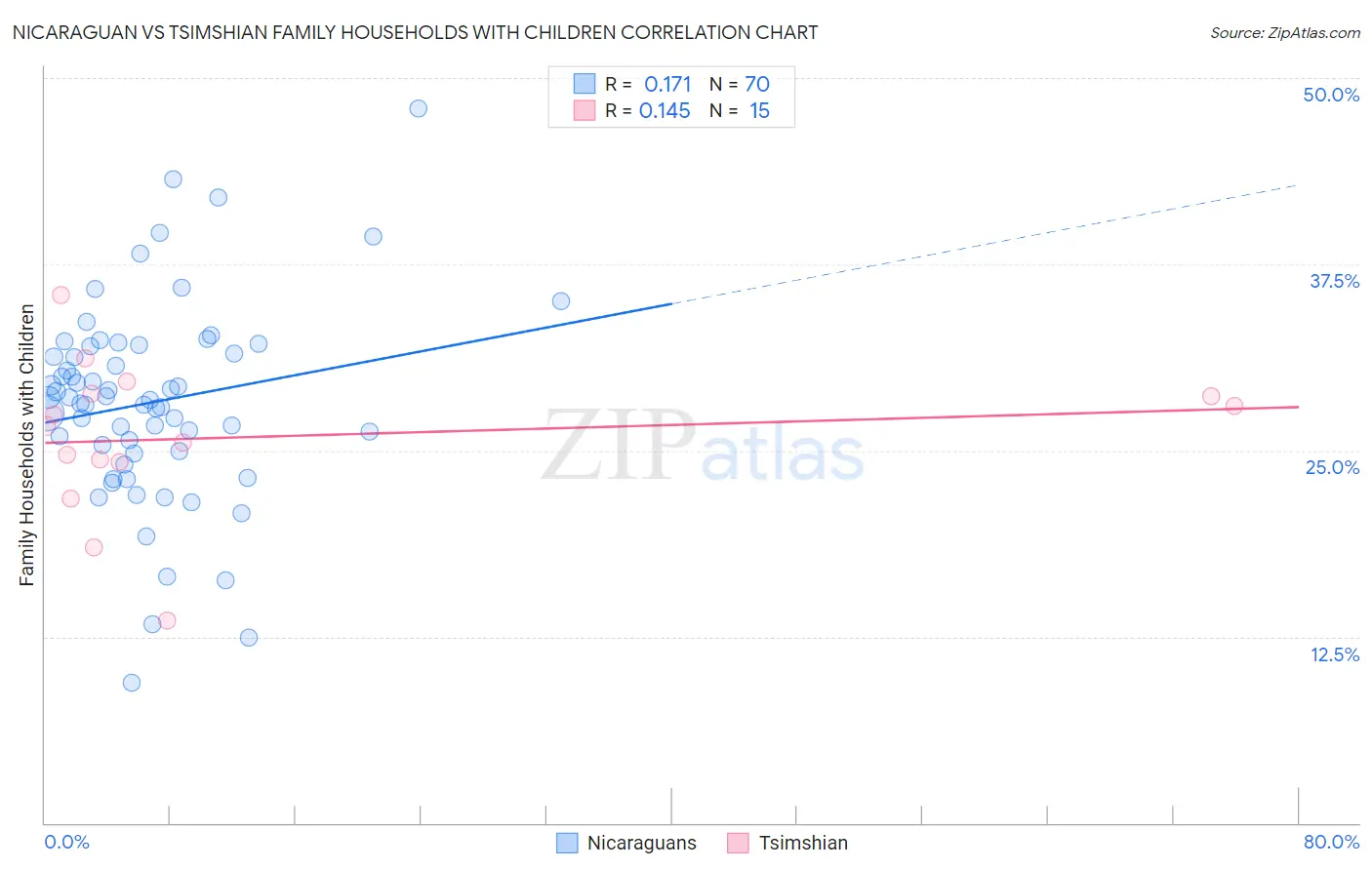Nicaraguan vs Tsimshian Family Households with Children
COMPARE
Nicaraguan
Tsimshian
Family Households with Children
Family Households with Children Comparison
Nicaraguans
Tsimshian
28.4%
FAMILY HOUSEHOLDS WITH CHILDREN
99.8/ 100
METRIC RATING
83rd/ 347
METRIC RANK
27.0%
FAMILY HOUSEHOLDS WITH CHILDREN
6.6/ 100
METRIC RATING
227th/ 347
METRIC RANK
Nicaraguan vs Tsimshian Family Households with Children Correlation Chart
The statistical analysis conducted on geographies consisting of 285,584,121 people shows a poor positive correlation between the proportion of Nicaraguans and percentage of family households with children in the United States with a correlation coefficient (R) of 0.171 and weighted average of 28.4%. Similarly, the statistical analysis conducted on geographies consisting of 15,626,544 people shows a poor positive correlation between the proportion of Tsimshian and percentage of family households with children in the United States with a correlation coefficient (R) of 0.145 and weighted average of 27.0%, a difference of 4.9%.

Family Households with Children Correlation Summary
| Measurement | Nicaraguan | Tsimshian |
| Minimum | 9.4% | 13.6% |
| Maximum | 47.9% | 35.4% |
| Range | 38.5% | 21.9% |
| Mean | 28.2% | 25.9% |
| Median | 28.5% | 26.6% |
| Interquartile 25% (IQ1) | 25.0% | 24.2% |
| Interquartile 75% (IQ3) | 32.0% | 28.8% |
| Interquartile Range (IQR) | 7.0% | 4.6% |
| Standard Deviation (Sample) | 6.7% | 5.2% |
| Standard Deviation (Population) | 6.7% | 5.1% |
Similar Demographics by Family Households with Children
Demographics Similar to Nicaraguans by Family Households with Children
In terms of family households with children, the demographic groups most similar to Nicaraguans are Costa Rican (28.4%, a difference of 0.0%), Immigrants from Syria (28.4%, a difference of 0.020%), Kenyan (28.4%, a difference of 0.050%), South American (28.4%, a difference of 0.090%), and Native/Alaskan (28.4%, a difference of 0.12%).
| Demographics | Rating | Rank | Family Households with Children |
| Immigrants | Sri Lanka | 99.9 /100 | #76 | Exceptional 28.4% |
| Nigerians | 99.8 /100 | #77 | Exceptional 28.4% |
| Immigrants | Nepal | 99.8 /100 | #78 | Exceptional 28.4% |
| Immigrants | Iraq | 99.8 /100 | #79 | Exceptional 28.4% |
| Natives/Alaskans | 99.8 /100 | #80 | Exceptional 28.4% |
| South Americans | 99.8 /100 | #81 | Exceptional 28.4% |
| Kenyans | 99.8 /100 | #82 | Exceptional 28.4% |
| Nicaraguans | 99.8 /100 | #83 | Exceptional 28.4% |
| Costa Ricans | 99.8 /100 | #84 | Exceptional 28.4% |
| Immigrants | Syria | 99.8 /100 | #85 | Exceptional 28.4% |
| Immigrants | Western Africa | 99.6 /100 | #86 | Exceptional 28.3% |
| Colombians | 99.6 /100 | #87 | Exceptional 28.3% |
| Liberians | 99.6 /100 | #88 | Exceptional 28.3% |
| Immigrants | Costa Rica | 99.6 /100 | #89 | Exceptional 28.3% |
| Immigrants | Thailand | 99.5 /100 | #90 | Exceptional 28.2% |
Demographics Similar to Tsimshian by Family Households with Children
In terms of family households with children, the demographic groups most similar to Tsimshian are Czechoslovakian (27.0%, a difference of 0.0%), Scottish (27.0%, a difference of 0.0%), Immigrants from Caribbean (27.0%, a difference of 0.030%), Canadian (27.1%, a difference of 0.080%), and Bulgarian (27.0%, a difference of 0.080%).
| Demographics | Rating | Rank | Family Households with Children |
| Austrians | 9.9 /100 | #220 | Tragic 27.1% |
| New Zealanders | 9.6 /100 | #221 | Tragic 27.1% |
| Paraguayans | 9.4 /100 | #222 | Tragic 27.1% |
| Pima | 9.2 /100 | #223 | Tragic 27.1% |
| Germans | 8.7 /100 | #224 | Tragic 27.1% |
| Canadians | 7.5 /100 | #225 | Tragic 27.1% |
| Czechoslovakians | 6.6 /100 | #226 | Tragic 27.0% |
| Tsimshian | 6.6 /100 | #227 | Tragic 27.0% |
| Scottish | 6.5 /100 | #228 | Tragic 27.0% |
| Immigrants | Caribbean | 6.3 /100 | #229 | Tragic 27.0% |
| Bulgarians | 5.8 /100 | #230 | Tragic 27.0% |
| Luxembourgers | 5.5 /100 | #231 | Tragic 27.0% |
| Yugoslavians | 5.1 /100 | #232 | Tragic 27.0% |
| Immigrants | Italy | 5.0 /100 | #233 | Tragic 27.0% |
| Immigrants | Germany | 4.4 /100 | #234 | Tragic 27.0% |